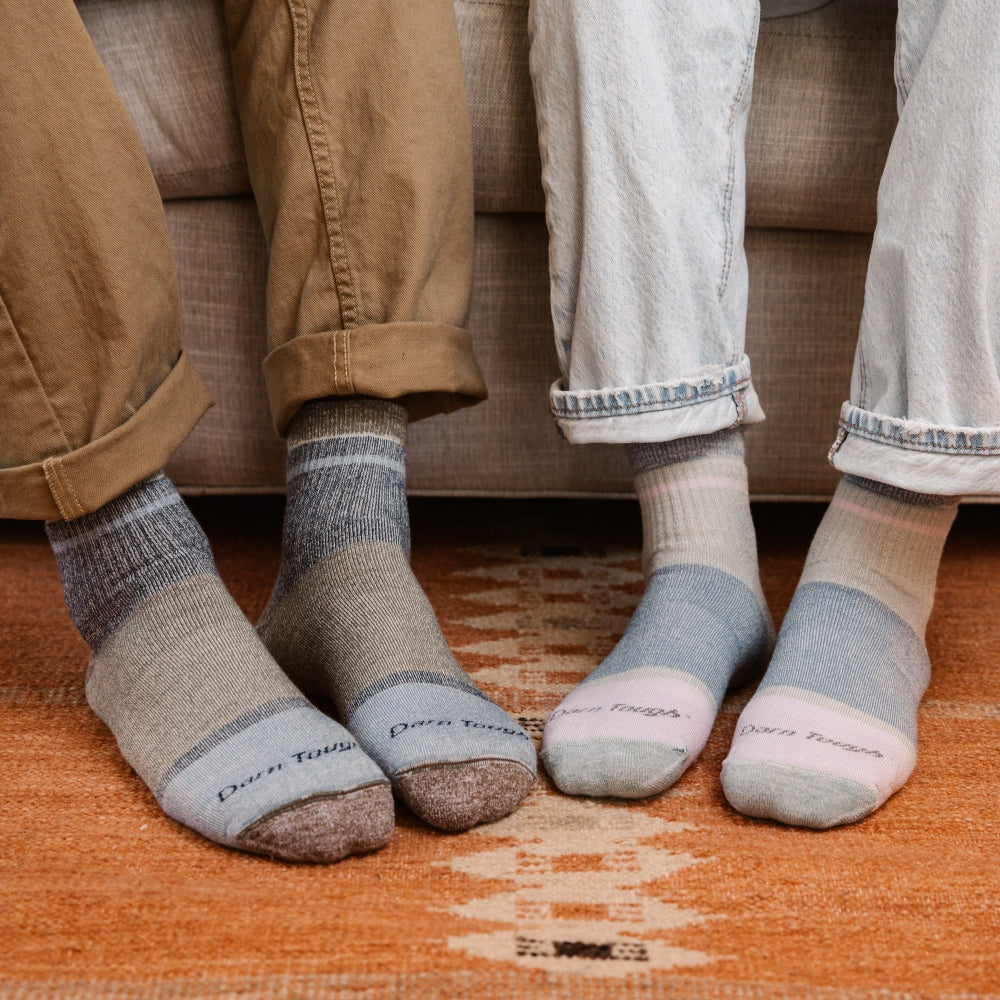Do I Need Sock Liners for Hiking?

The Great Debate: Are hiking sock liners necessary?
An enduring discussion in the hiking community is, “Should I wear sock liners to prevent blisters while hiking?”
With thousands of miles on trail in recent years, some of which included sock-liner testing, I have found that the advice to pair sock liners with hiking socks seems to ignore technological sock innovations of the last 10-15 years ago. However, I still know plenty of hikers of all ages, shapes, and sizes, wearing all different types of footwear, who swear by them.
In this post I’m going to get into the pros and cons of liner socks to help you determine your best footwear system. Spoiler: I truly don’t think you need liners if you have the right sock and shoe combo. So let’s get into it…
What are liner socks? And why use them?
Basically, a liner sock is a thinner sock, often made of polyester, wool, and/or silk, that is meant for layering under a thicker pair of socks. Meant to be super form-fitting, they can act almost like an extra skin over your feet to prevent hot spots or friction zones. Often the materials are made to wick moisture away into the outer sock.

By wearing thinner socks that sculpt over your foot, the idea is that any rubbing/shifting from your non-liner sock or footwear rubs the liner sock instead of directly impacting your feet, therefore preventing blisters and hotspots. This concept is similar to why you might wear spandex underwear or base layers or use an athletic friction-reducing balm to prevent chafing.
At the heart of the above reasoning is the assumption that your footwear or socks are giving you blisters. Personally, I am a believer that liners are treating the symptom of blisters, rather than dealing with a bad shoe or sock fit causing the issue in the first place.
What causes blisters?

Simply, most blisters are caused by friction or heat, creating space between layers of skin that in turn fills with fluid.
Even more simply put: Blisters suck. They are painful and can turn a great run or hike into a terrible outing if left untreated.
When hiking or running, some key blister culprits can include:
- Wrong or ill-fitting footwear, either too tight or too loose. If your shoes are too tight, you hinder the natural movement of your feet as they shift to meet the terrain. This can cause hot spots. Too much movement, or shifting inside your shoe, can also cause friction. It’s important to have the right shoe fit for your feet and the activity you’re undertaking. Make sure your sock choices complement that fit and don’t change it too much. Liners, for instance, can create too much material inside your shoe.
- Junk inside your shoes that shouldn’t be there. Pro tip I learned from my running coach (an FKT holder on several major trails): keep your footwear clean inside and wash your insoles. Tiny dirt, rocks, or debris can turn into a major issue in the form of a hot spot. On wet days, dirt can turn to mud and cake under the balls of your feet and behind your heels, causing friction. This can happen whether you’re wearing liners or not. If dirt, pine needles, rocks, etc. remain an issue, I would recommend using gaiters to keep debris out of your footwear.
- Bunching/loose-fitting socks. This is the BIG one to consider with liner socks and why I think a lot of liner tips are outdated. Sock technology has come a long way in the last 15 years, with improved fit and high-density knitting. Most hike and backpack socks of the past were bulky or loose, which would slip or bunch up in places, creating friction or hot spots. With socks like that, I can see why liners were tempting. A proper performance fit can eliminate the need for liners.
- Excess moisture (which can, in turn, cause bunching). On wet days, or sweaty days with non-moisture wicking materials like cotton, moisture can bog down your socks, impacting their fit and causing them to slip. Keep your feet dry and wear socks made of moisture wicking fibers (Merino Wool is my recommendation) with spandex reinforcement to prevent slippage.

What about toe socks?
I do know some hikers and ultra-runners who swear by toe socks or toe-sock liners, saying they prevent blisters on or around toes. While this may be the case for them, I find that a properly fitting shoe with ample toe room will make sure my toes aren’t too crushed together, so they can work as intended.
Other toe sock wearers claim that toe socks help their toes spread properly and work the way they’re supposed to. If that’s the case for them, I am not here to judge. However, I would caution that this reasoning may be undone if you are then putting your feet into another pair of socks and then all of that into a shoe. Check first to make sure your shoes and non-liner socks are a good fit.

Additionally, toe socks can cause blisters by cramming excess material into an otherwise well-fitting shoe or creating friction between the toes with added material.
In the end, I would say toe socks as liners come down to preference and individual fit.
Issues with liners and toe socks
The main issues I’ve had when trying hiking sock liners (traditional and toe-sock style) include:
- Too much material.
- The liners falling apart.
- Hiding an underlying boot-sock fit issue.
Adding a liner sock may be treating a symptom rather than the core fit issue on a shoe or the main hiking sock.

Another bummer about most sock liners is that they are inherently non-durable. Since they are knit as thin as possible and meant to be worn under other socks, they can fall apart quickly in key zones where you needed protection in the first place.
Key sock components so you can skip the liners
If I’ve convinced you that you don’t need sock liners for hiking, you may be wondering how to adjust your current footwear system.
Start with the right socks. Darn Tough socks are designed to be worn without liners. As mentioned above, you shouldn’t need liners if your socks have a performance fit and are properly wicking away moisture and regulating temperature. This is where Darn Tough excels.
Darn Tough’s performance fit keeps the socks where you want them. Set them and forget them. The best socks are those you don’t notice, with no blister-causing bunching or slipping.

All our socks are knit with Merino Wool (or Coolmax or Thermolite synthetic materials in select vegan-friendly styles) to wick moisture away from your feet, control temperature, and maximize blister prevention. This will keep your feet cool in warm weather, warm in cold weather, feeling fresher, and more comfortable.
Need a little impact protection? Got a backpack trip coming up where you'll be carrying extra weight? Grab a pair of cushioned socks! All our hiking socks feature Lightweight, Midweight, or heavier cushioning underfoot, around the toes, and behind the heel.
This helps prevent blisters by putting some comfort between your shoe and foot in key zones. The added performance fiber also aids in moisture management in those same spots.
You’ll also want to make these socks are the right size. Check the size chart and, if you’re between sizes, consider sizing up, since the performance fit keeps things close.

Perhaps the most important thing on trail to not lose sight of is your overall footwear system, made up of your feet, socks, and shoes or boots. Your socks and shoes should be considered together, rather than separately.
After you’ve got your hands on hiking socks with a performance fit and moisture wicking material, you’ll want to test the fit of those socks with your hiking boots or shoes. Likewise, if you have a favorite pair of shoes or boots, make sure you’re picking a sock to will fit well with it. The best footwear in the world is useless if your sock isn’t right.
Does Darn Tough make sock liners?
So if I didn’t convince you to ditch the liners, you may be asking “Does Darn Tough have an option for liner lovers?”
In short, no we do not have official liners, but we do have models that do work well as a liner option under thicker socks.

In the past, I’ve tested our non-cushioned Ultra-Lightweight or Lightweight wool socks and seen success. While I didn’t need them, they did the job liner-users look for.
And, as an added bonus, since these socks weren’t meant to be just liners, they were knit with reinforcement and backed with a lifetime warranty.
In conclusion... do I need sock liners?
No, not if you’re wearing a Merino Wool sock with a performance fit, like Darn Tough socks. If blisters remain an issue for you, I recommend checking the fit of your socks and your shoes first and adjusting as needed to become blister free.
Sock, insole, and shoe technology continues to advance in amazing ways, eliminating the need for bulky equipment that required liners in the past. Keep things streamlined and invest, if you can, for the right fit and good materials. Your feet will thank you!







